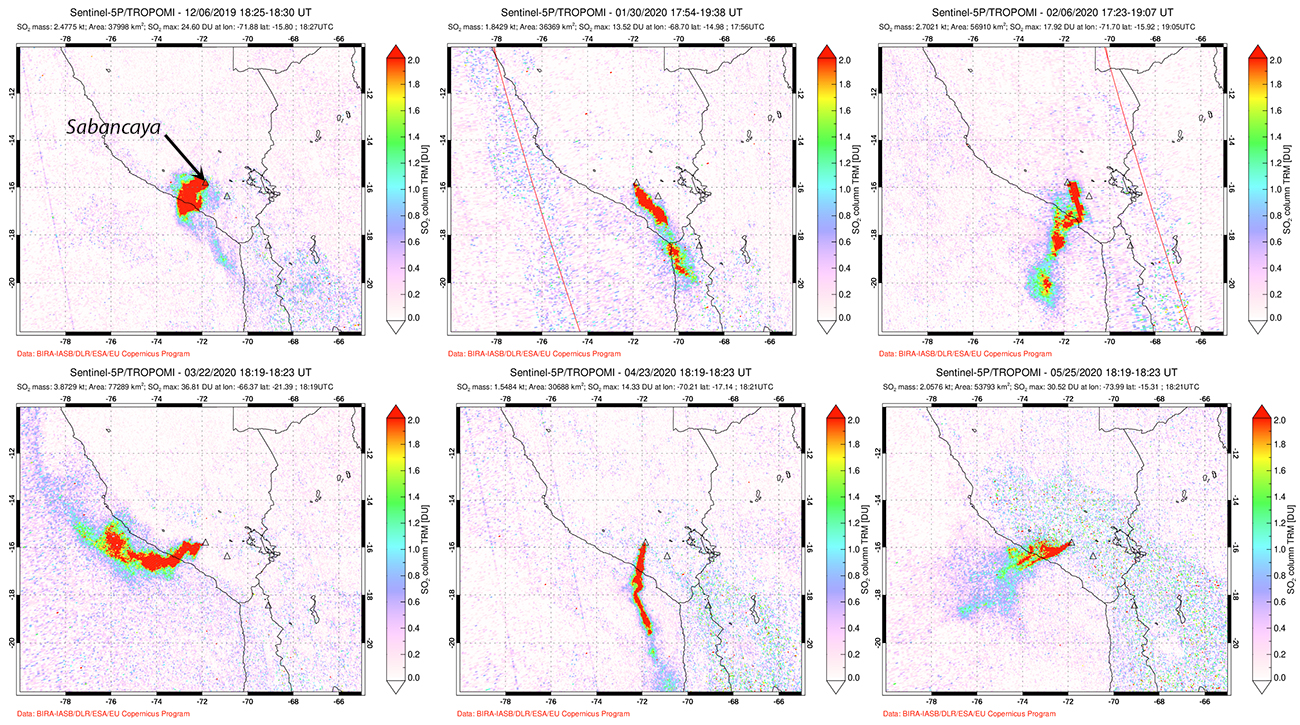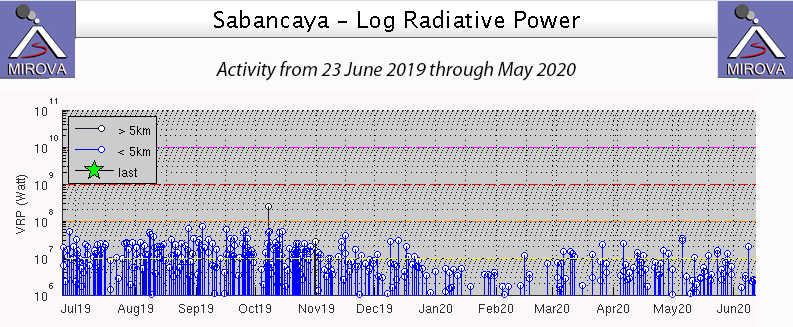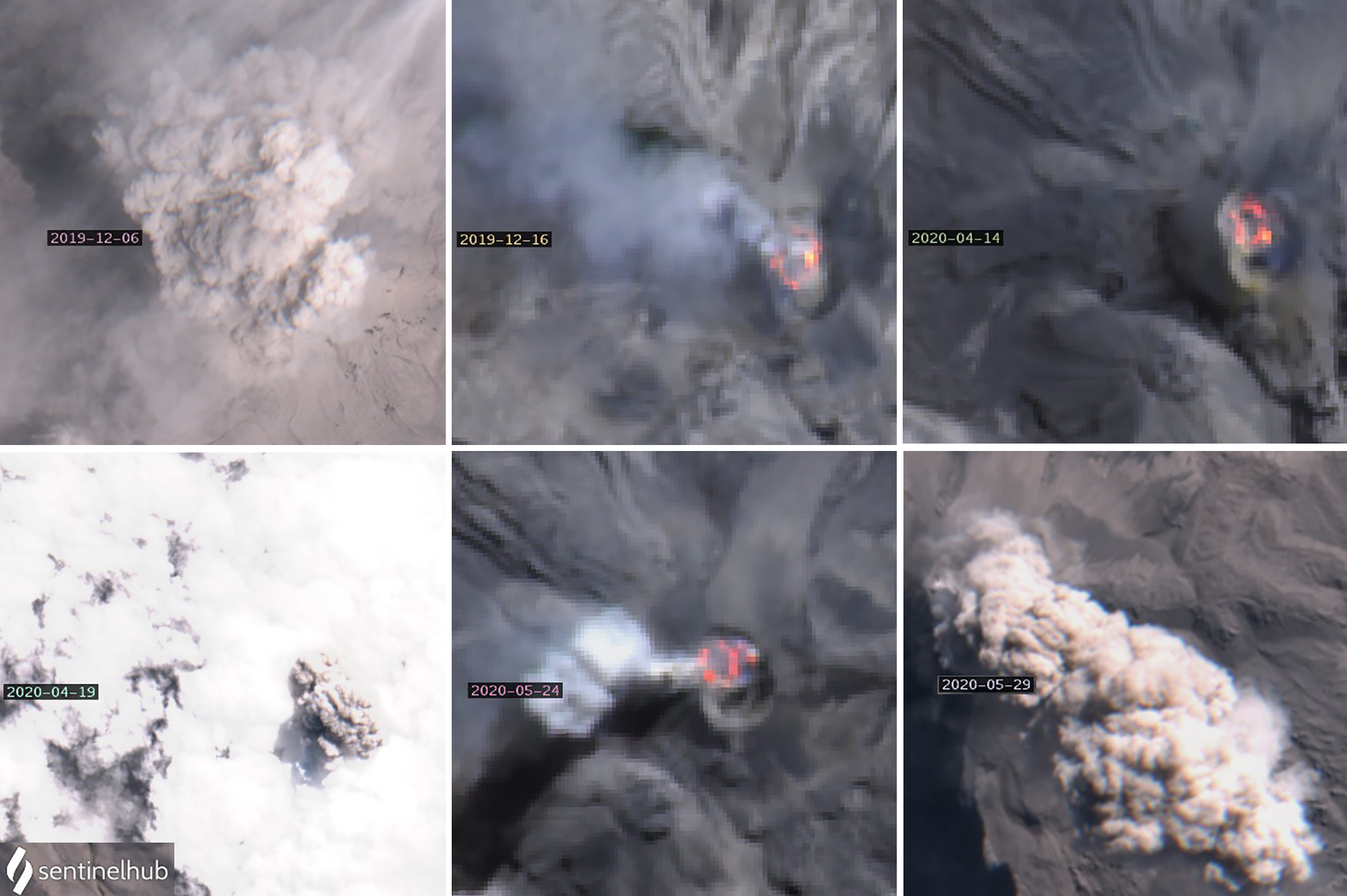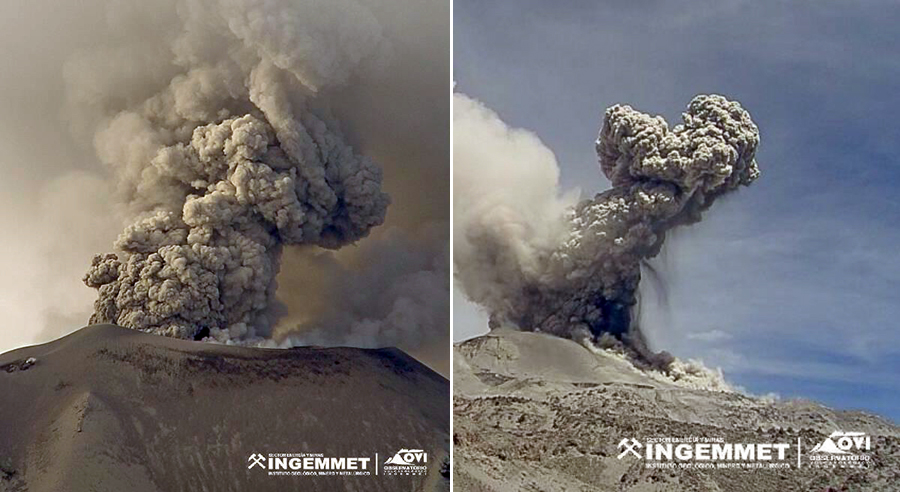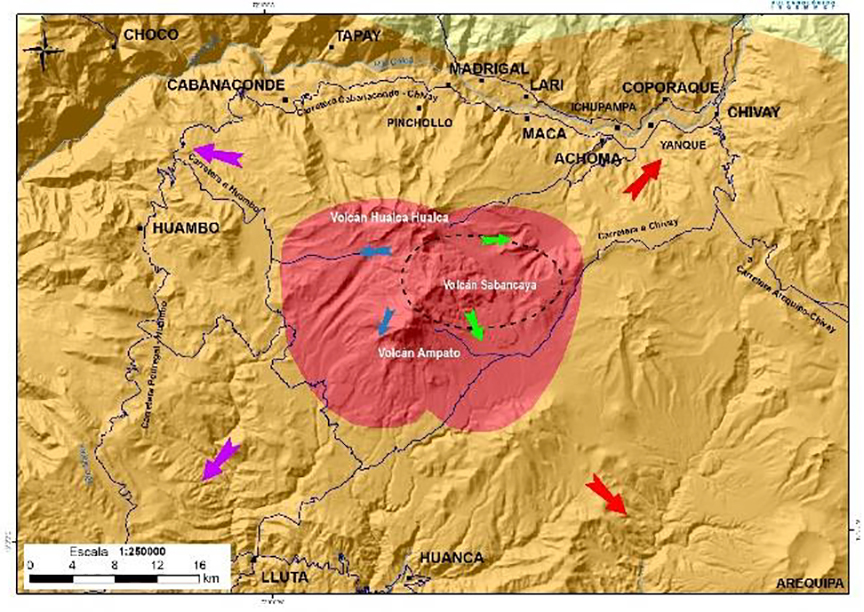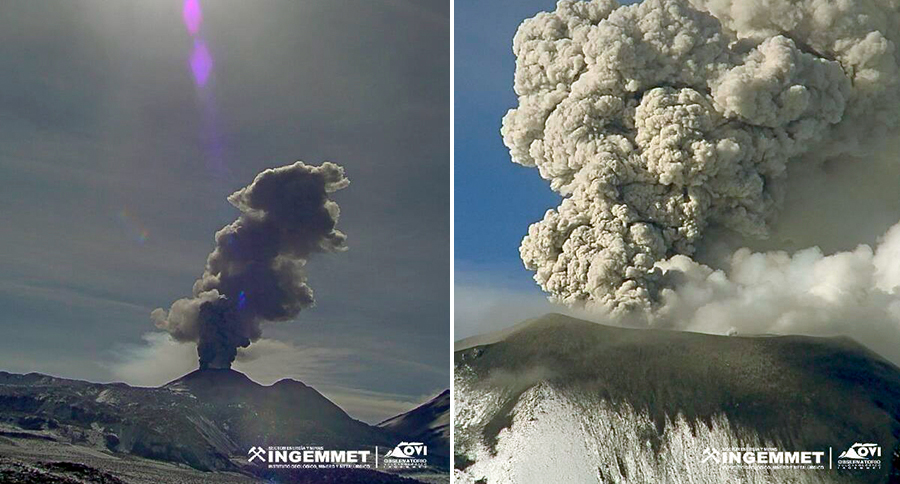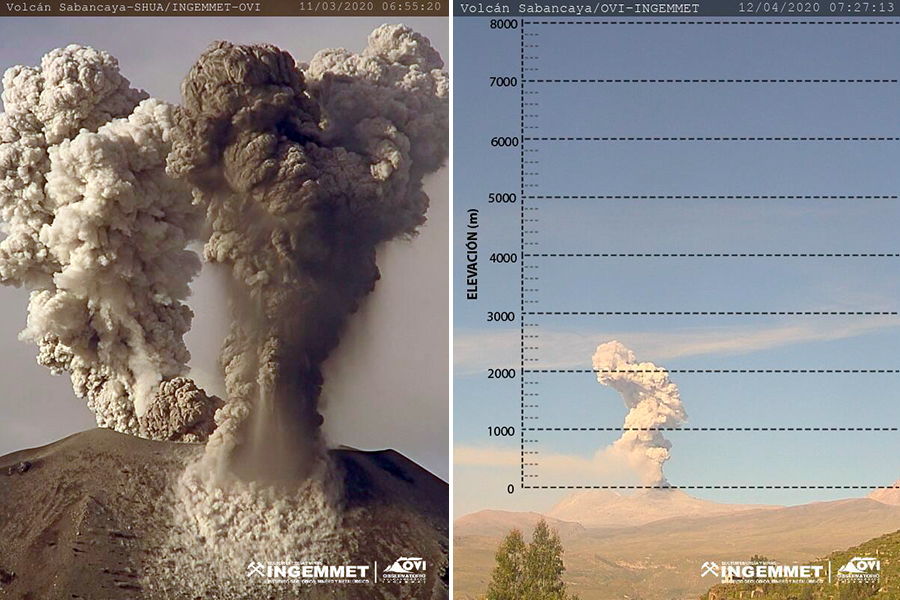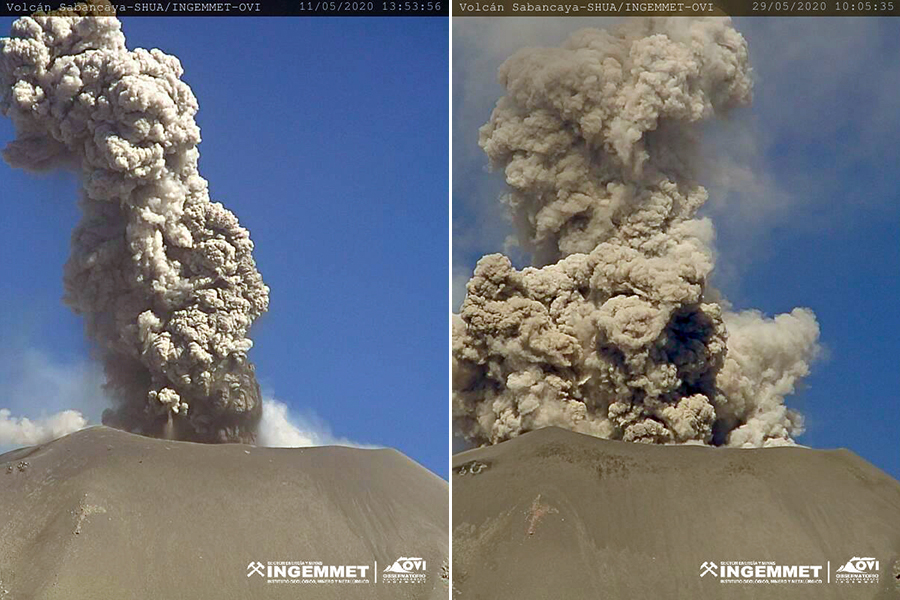Report on Sabancaya (Peru) — June 2020
Bulletin of the Global Volcanism Network, vol. 45, no. 6 (June 2020)
Managing Editor: Edward Venzke.
Edited by A. Elizabeth Crafford.
Sabancaya (Peru) Daily explosions with ash emissions, large SO2 flux, ongoing thermal anomalies, December 2019-May 2020
Please cite this report as:
Global Volcanism Program, 2020. Report on Sabancaya (Peru) (Crafford, A.E., and Venzke, E., eds.). Bulletin of the Global Volcanism Network, 45:6. Smithsonian Institution. https://doi.org/10.5479/si.GVP.BGVN202006-354006
Sabancaya
Peru
15.787°S, 71.857°W; summit elev. 5960 m
All times are local (unless otherwise noted)
Although tephrochronology has dated activity at Sabancaya back several thousand years, renewed activity that began in 1986 was the first recorded in over 200 years. Intermittent activity since then has produced significant ashfall deposits, seismic unrest, and fumarolic emissions. A new period of explosive activity that began in November 2016 has been characterized by pulses of ash emissions with some plumes exceeding 10 km altitude, thermal anomalies, and significant SO2 plumes. Ash emissions and high levels of SO2 continued each week during December 2019-May 2020. The Observatorio Vulcanologico INGEMMET (OVI) reports weekly on numbers of daily explosions, ash plume heights and directions of drift, seismicity, and other activity. The Buenos Aires Volcanic Ash Advisory Center (VAAC) issued three or four daily reports of ongoing ash emissions at Sabancaya throughout the period.
The dome inside the summit crater continued to grow throughout this period, along with nearly constant ash, gas, and steam emissions; the average number of daily explosions ranged from 4 to 29. Ash and gas plume heights rose 1,800-3,800 m above the summit crater, and multiple communities around the volcano reported ashfall every month (table 6). Sulfur dioxide emissions were notably high and recorded daily with the TROPOMI satellite instrument (figure 75). Thermal activity declined during December 2019 from levels earlier in the year but remained steady and increased in both frequency and intensity during April and May 2020 (figure 76). Infrared satellite images indicated that the primary heat source throughout the period was from the dome inside the summit crater (figure 77).
Table 6. Persistent activity at Sabancaya during December 2019-May 2020 included multiple daily explosions with ash plumes that rose several kilometers above the summit and drifted in many directions; this resulted in ashfall in communities within 30 km of the volcano. Satellite instruments recorded SO2 emissions daily. Data courtesy of OVI-INGEMMET.
| Month | Avg. Daily Explosions by week | Max plume Heights (m above crater) | Plume drift (km) and direction | Communities reporting ashfall | Min Days with SO2 over 2 DU |
| Dec 2019 | 16, 13, 5, 5 | 2,600-3,800 | 20-30 NW | Pinchollo, Madrigal, Lari, Maca, Achoma, Coporaque, Yanque, Chivay, Huambo, Cabanaconde | 27 |
| Jan 2020 | 10, 8, 11, 14, 4 | 1,800-3,400 | 30 km W, NW, SE, S | Chivay, Yanque, Achoma | 29 |
| Feb 2020 | 8, 11, 20, 19 | 2,000-2,200 | 30 km SE, E, NE, W | Huambo | 29 |
| Mar 2020 | 14, 22, 29, 18 | 2,000-3,000 | 30 km NE, W, NW, SW | Madrigal, Lari, Pinchollo | 30 |
| Apr 2020 | 12, 12, 16, 13, 8 | 2,000-3,000 | 30 km SE, NW, E, S | Pinchollo, Madrigal, Lari, Maca, Ichupampa, Yanque, Chivay, Coporaque, Achoma | 27 |
| May 2020 | 15, 14, 6, 16 | 1,800-2,400 | 30 km SW, SE, E, NE, W | Chivay, Achoma, Maca, Lari, Madrigal, Pinchollo | 27 |
The average number of daily explosions during December 2019 decreased from a high of 16 the first week of the month to a low of five during the last week. Six pyroclastic flows occurred on 10 December (figure 78). Tremors were associated with gas-and-ash emissions for most of the month. Ashfall was reported in Pinchollo, Madrigal, Lari, Maca, Achoma, Coporaque, Yanque, and Chivay during the first week of the month, and in Huambo and Cabanaconde during the second week (figure 79). Inflation of the volcano was measured throughout the month. SO2 flux was measured by OVI as ranging from 2,500 to 4,300 tons per day.
During January and February 2020 the number of daily explosions averaged 4-20. Ash plumes rose as high as 3.4 km above the summit (figure 80) and drifted up to 30 km in multiple directions. Ashfall was reported in Chivay, Yanque, and Achoma on 8 January, and in Huambo on 25 February. Sulfur dioxide flux ranged from a low of 1,200 t/d on 29 February to a high of 8,200 t/d on 28 January. Inflation of the edifice was measured during January; deformation changed to deflation in early February but then returned to inflation by the end of the month.
Explosions continued during March and April 2020, averaging 8-29 per day. Explosions appeared to come from multiple vents on 11 March (figure 81). Ash plumes rose 3 km above the summit during the first week of March and again the first week of April; they were lower during the other weeks. Ashfall was reported in Madrigal, Lari, and Pinchollo on 27 March and 5 April. On 17 April ashfall was reported in Maca, Ichupampa, Yanque, Chivay, Coporaque, and Achoma. Sulfur dioxide flux ranged from 1,900 t/d on 5 March to 10,700 t/d on 30 March. Inflation at depth continued throughout March and April with 10 ± 4 mm recorded between 21 and 26 April. Similar activity continued during May 2020; explosions averaged 6-16 per day (figure 82). Ashfall was reported on 6 May in Chivay, Achoma, Maca, Lari, Madrigal, and Pinchollo; heavy ashfall was reported in Achoma on 12 May. Additional ashfall was reported in Achoma, Maca, Madrigal, and Lari on 23 May.
Geological Summary. Sabancaya, located in the saddle NE of Ampato and SE of Hualca Hualca volcanoes, is the youngest of these volcanic centers and the only one to have erupted in historical time. The oldest of the three, Nevado Hualca Hualca, is of probable late-Pliocene to early Pleistocene age. The name Sabancaya (meaning "tongue of fire" in the Quechua language) first appeared in records in 1595 CE, suggesting activity prior to that date. Holocene activity has consisted of Plinian eruptions followed by emission of voluminous andesitic and dacitic lava flows, which form an extensive apron around the volcano on all sides but the south. Records of observed eruptions date back to 1750 CE.
Information Contacts: Observatorio Volcanologico del INGEMMET (Instituto Geológical Minero y Metalúrgico), Barrio Magisterial Nro. 2 B-16 Umacollo - Yanahuara Arequipa, Peru (URL: http://ovi.ingemmet.gob.pe); Buenos Aires Volcanic Ash Advisory Center (VAAC), Servicio Meteorológico Nacional-Fuerza Aérea Argentina, 25 de mayo 658, Buenos Aires, Argentina (URL: http://www.smn.gov.ar/vaac/buenosaires/inicio.php); Global Sulfur Dioxide Monitoring Page, Atmospheric Chemistry and Dynamics Laboratory, NASA Goddard Space Flight Center (NASA/GSFC), 8800 Greenbelt Road, Goddard, Maryland, USA (URL: https://so2.gsfc.nasa.gov/); MIROVA (Middle InfraRed Observation of Volcanic Activity), a collaborative project between the Universities of Turin and Florence (Italy) supported by the Centre for Volcanic Risk of the Italian Civil Protection Department (URL: http://www.mirovaweb.it/); Sentinel Hub Playground (URL: https://www.sentinel-hub.com/explore/sentinel-playground).


